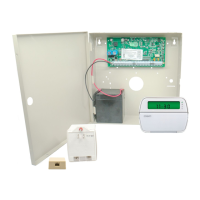Chapter 4 Programming Descriptions
17
[030] Fast Loop Response
This section is used to determine the Loop Response Time for the main panel zones.
[101] to [164] Zone Attributes
These sections are used to customize the operation of the zones. There are 9 toggle options in each section:
Keypad zones and zone expanders will always follow [013].
When Zone Types ([001] to [004]) are programmed, the system will change the Zone Attributes to those found in the chart included in the
Programming Worksheets. The Zone Attributes will default if a new Zone Type is programmed for a specific zone. After programming the Zone
Types, enter
[101] to [164] and ensure that all options are programmed correctly.
Ready light ON: Program attributes [1-8] (press [1]-[8] to turn option ON or OFF)
Ready light and Armed light ON: Program attributes [9-16] (press [1]-[8] to turn option ON or OFF)
Press [9] to switch between attributes [1-8] and attribute [9-16].
[165] Maximum Dialing Attempts
Program the Maximum Dialing Attempts before the panel will generate a Failure to Communicate (FTC) trouble condition.
Valid entries are
[001] to [005]. For UL Listed installations, 5 attempts is required.
[5]
ON: the user cannot switch from Away Arm mode to Stay Arm mode using the function keys.
OFF: the user can switch arming modes.
[6]
ON: the system disconnects a listen in/two-way session if a new event occurs.
OFF: the system does NOT disconnect. New events are transmitted only after the session is terminated.
[7]
ON: the system does NOT activate the keypad buzzer for any trouble condition (excluding Fire Troubles).
OFF: the system announces troubles via the keypad buzzer (two beeps every 10 seconds).
[8]
ON: Keyswitches will always arm in Away mode.
OFF: Keyswitches will arm in Away mode if an entry/exit zone is violated during exit delay.
ON: the loop response time will be 36 ms. OFF: the loop response time will be 400 ms.
Option Description
[1]
ON: alarms are audible (bell output).
OFF: alarms are silent.
[2]
ON: the bell output is steady (burglary).
OFF: the alarm output pulses (fire).
[3]
ON: a zone violation or restoral will activate Chime.
OFF: Chime is not activated.
[4]
ON: the user can manually bypass the zone using the [][1] command.
OFF: the zone cannot be manually bypassed.
[5]
ON: the partition can be armed even if the zone is violated (the zone will not affect the Ready status).
OFF: the zone must be secure before arming.
[6]
ON: the system shuts down alarm reporting after the programmed number of alarms have occurred.
OFF: the panel will always report the event if an alarm occurs.
[7]
ON: the system delays reporting the event for the time programmed for the Transmission Delay time.
OFF: the panel immediately transmits the reporting event when an alarm is detected.
[8]
ON: the zone is a wireless or addressable device.
OFF: the zone is a hardwire zone (main panel, zone expander or keypad zone).
[9]
ON: the zone has the Cross Zone feature enabled.
OFF: the zone functions normally.
[10]-[13]
For Future Use
[14]
ON: the zone requires a normally-closed loop
OFF: the zone will follow the EOL configuration in [013]
[15]
ON: the zone requires a single End-of-Line resistor
OFF: the zone will follow the EOL configuration in [013]
[16]
ON: the zone requires double End-of-Line resistors
OFF: the zone will follow the EOL configuration in [013]
Options [14], [15], [16] apply to first 8 zones only. If more than one of these options are enabled then lowest numbered option is enabled. E.g.,
If Option [14] and option [15] are enabled then the zones are configured as normally closed loops.

